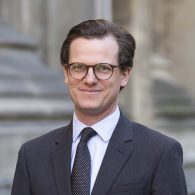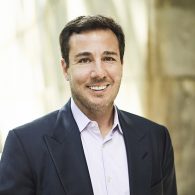The global 200 in profile – big law media benchmarking report
December 17, 2020 • 10 minute read
Introduction
Being one of the largest law firms in the world is an honour that carries prestige and industry admiration. Yet, within this elite realm, competition is intense – both for work and talent – and profile counts.
There is a great advantage to standing out from the crowd, and, for most law firms, media strategy is an essential part of business planning. But what does good look like? And how is profile quantified?
This first of its kind report from Infinite Global answers these questions by investigating the media footprints of the Global 200 law firms. By providing new data and bespoke analysis, it seeks to quantify profile, define parameters for success and to help explain the process behind excellent performance.
The report also looks at the impact of Covid-19 on law firm profile.
The full media data, taken from the first half of 2020, has been collated to create a unique benchmarking tool which can be accessed online here.
The data will be updated on a regular basis to provide an enduring resource from which to measure and track law firm profile over time.
It is our hope that by continuing to monitor profile, measuring success and documenting challenges overcome, we can stimulate discussion and continue to evolve best practice for the benefit of the industry at large.
Key benchmarks
In summary, our data reveals the following key annual benchmarks for Global 200 law firm profile.
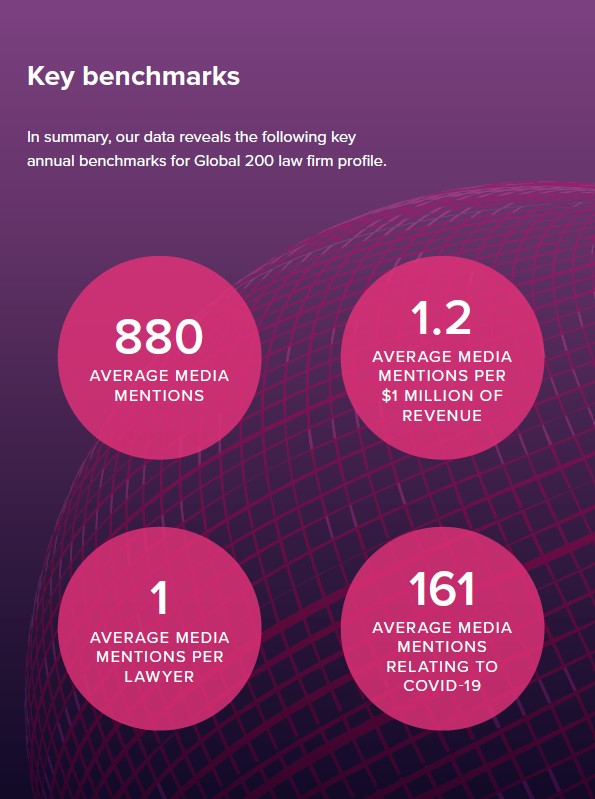
Does size matter?
Yes. Of the top ten firms by media footprint, five feature in the top ten by overall revenue, with Kirkland & Ellis, the largest firm in the world by revenue, found to have the largest media footprint of all for the six-month period studied (3,262 media mentions).
The smallest firm by revenue in the top ten media coverage ranking is Davis Polk & Wardwell, still the 26th largest firm in the world (1,301 media mentions). In fact, of the top 50 firms by revenue, 40 rank within the top 50 by media mentions, a clear indication that there is a media profile advantage to being large.
This is not unexpected. Already recognizable brands will, by their nature, attract greater media attention. The greater a firm’s revenue, and the higher its position in the Global 200, the more it is seen as an industry leader worthy of media comment and attention.
“When you’re one of the largest law firms in the world, whatever you do is of profession-wide significance,” says Anne Groves former Global Head of PR at Clifford Chance, “some days even the Managing Partner blowing their nose seems to be news.”
Economies of scale are also at work – the larger the firm the greater the news flow with appointments, hires, deals and instructions all likely to increase relative to a firm’s size.
Journalists may also have a greater baseline awareness of the firms at the top of the list, making it more likely that they are namechecked in passing, as well as being the first port of call for speculative comment opportunities – as Groves says: “The biggest firms are the natural starting point for journalists”.
However, size isn’t everything.

Being bold – belief in brand
“Any great brand talks,” says Elliot Moss, Partner and Director of Business Development at Mishcon de Reya. Having nearly quadrupled the firm’s revenue in the last ten years, Moss knows that brand is a significant force for growth and that, along with advertising and content, it is driven by PR – a lever that the firm uses “aggressively.”
“For us it’s not just about PR, it’s about what PR can do for the business,” says Moss. The firm tracks metrics closely and they see a direct link between media profile and new opportunities. He explains that media profile increases awareness of the firm which in turn increases salience – “a comprehension of what the firm offers” – which then drives consideration. As Moss puts it: “If you’ve heard of Mishcon de Reya and you know what Mishcon de Reya does, you’re more likely to consider, and instruct, Mishcon de Reya.”
Importantly, this faith in the value of brand, and the power of PR to drive it, is supported throughout the business. It is encapsulated by the firm’s media strategy – to be bold – which is in line with one of the firm’s core values. According to Moss, this boldness manifests itself in the belief, held across the firm, that talking is really important, that having an opinion is really important, and that putting the firm’s experts in front of the media is really important – so long as they have a “clear brief”.
In agreement that the firm is going to communicate a lot, boldness then guides what Mishcon de Reya actually talks about, and the more interesting the better. “We’ve become a talking point ourselves,” says Moss who points to the some of the moves that the firm has made over the years such as free holidays, flexible working (“long before it was commonplace”), an apprenticeship scheme, appointing partners that are not lawyers and setting up non-legal businesses like the firm’s brand management arm. Moss explains: “We are always asking ourselves what is it that we are doing that we can share? Everything is news if you can make it interesting.”
Who’s getting Bang for Buck?
Applying analysis to our data and looking at media mentions compared to revenue we are able to create a Bang for Buck ratio. This metric shows the firms that are punching above their weight in media terms and highlights whose profile outstrips that of their peers by revenue.
It places US-headquartered Haynes and Boone at number one with 1.60 media mentions per $1 million of revenue for the six-month period studied (an annualised figure of 3.2 media mentions per $1 million of revenue).
The smallest firm with a top ten punch is Ballard Spahr with 1.26 media mentions per $1 million USD of revenue (2.52 annualised).
Commenting on the ranking, Murray Coffey, Chief Marketing Officer at Haynes and Boone says: “We are a growth-oriented firm which keeps us hungry and always reaching forward. A strong and vibrant media profile is an indispensable component in this effort.” He also adds: “I know we are doing something right when a client says ‘I just see your firm everywhere.”
Of the top ten firms by Bang for Buck, seven have an exclusively, or majority, US presence. The only firms based outside the US are Clayton Utz, Australia’s largest full-service law firm, with 1.29 media mentions per $1 million USD of revenue (2.58 annualised) and the UK’s Mishcon de Reya with 1.27 media mentions per $1 million USD of revenue (2.54 annualised) – an exceptional achievement for Mishcon de Reya given the firm only has two offices (London and Singapore).
“65 percent of our work doesn’t have a UK component to it,” says Hayley Geffin, Head of Communications and PR at Mishcon de Reya, she adds: “We’re more likely to have clients in Kuala Lumpur than Newcastle.” Accordingly, the firm takes an agnostic approach to geography, instead cultivating a reputation around business issues in a global context. “Through the lens of international business, we communicate on topics where it is interesting to note the legal perspective,” says Geffin.
She adds that achieving Bang for Buck takes time and, while the firm has a “well-oiled” PR machine, it needs a lot of work. She cautions: “You can’t manufacture profile from no-where in an instant. What might seem like overnight success has been ten years in the making.”
So how much media profile does $1 million buy?
Average Bang for Buck across the Global 200 is 0.60 media mentions per $1m USD of revenue (1.20 annualised). If we look at the average for the Global 100 firms, it is lower than the overall at 0.57 media mentions per $1 million (1.14 annualised), while for firms 100 to 200 it increases to 0.63.
Investigating further, we can see that on average those firms that are getting the best Bang for Buck occupy positions 126 to 150 by revenue with an average of 0.69 mentions per $1 million USD of revenue (1.38 annualised). This is followed closely by firms in positions 101 to 125 with an average of 0.65 mentions per $1m USD of revenue (1.2 annualised).
There is a marked difference between the firms in these bands and the rest of the Global 200. This is likely an indication of greater earned media activity undertaken by these firms in order to augment profile and compete with larger peers.
Indeed, Geffin points to a direct link between profile activity and securing work: “Our objective is to drive awareness. We want to grow our business and we are bold in our communications because we know that leads to instructions.”
This is also well understood by Coffey. “We are working hard to establish our brand in a highly competitive marketplace,” he says, “we are smaller, younger and still maturing but media is an equalizer.”
Coffey also points out how being outside the Global 100 can be a benefit when seeking to grow media profile. “Media is also a strategic advantage for us,” he says when discussing internal chains of command and client conflicts, “we can move faster and have less layers of bureaucracy than our larger rivals.”
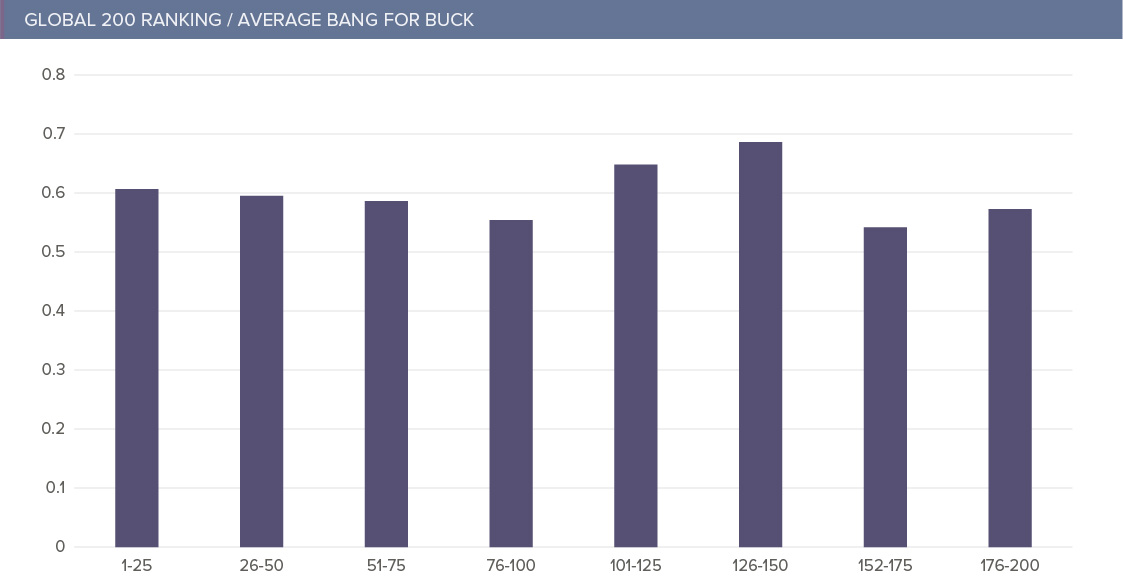
Are US firms getting more for their money?
So why is it that of the top ten firms ranked by Bang for Buck, seven have an exclusively, or majority, US presence?
Analysis of their media profiles shows the prominence of US regional media mentions in the results with the volume of mentions from these sources vastly contributing to overall media footprint. This, of course, should be of no surprise. The US is not only the largest media market in the world but also possibly the most interested in the legal profession and the most hungry for legal news and views.
“Lawyers are seen as superstars in the US,” says Groves, “it is a litigious market, and they are taken very seriously”. She also notes the interplay between private practice and public office where it is not uncommon for prominent US lawyers at top firms to have previously held positions “at the heart of government.”
Furthermore, a strong physical presence in the regions facilitates regional media mentions. Comparing the number of US offices for each of the US firms by their Bang for Buck ratio shows a distinct trend – the more US offices, the greater their media punch.
Leveraging this local US media appetite clearly gives a profile advantage but only for those who choose to seize the opportunity and capitalise on the familiarity factor of regional presence. There are many US firms in our research who do not enjoy strong US regional profiles despite large numbers of regional offices.
For Coffey it comes down to overall strategic media objectives. “We want to be known as a national powerhouse with global reach,” he explains, “we welcome more global coverage but know that we still have work to do in the US.”
According to Coffey the key to maintaining such a media strategy is discipline. “Don’t snap at every opportunity,” he advises, “push back on out-of-scope requests and focus on strategic priorities first.”
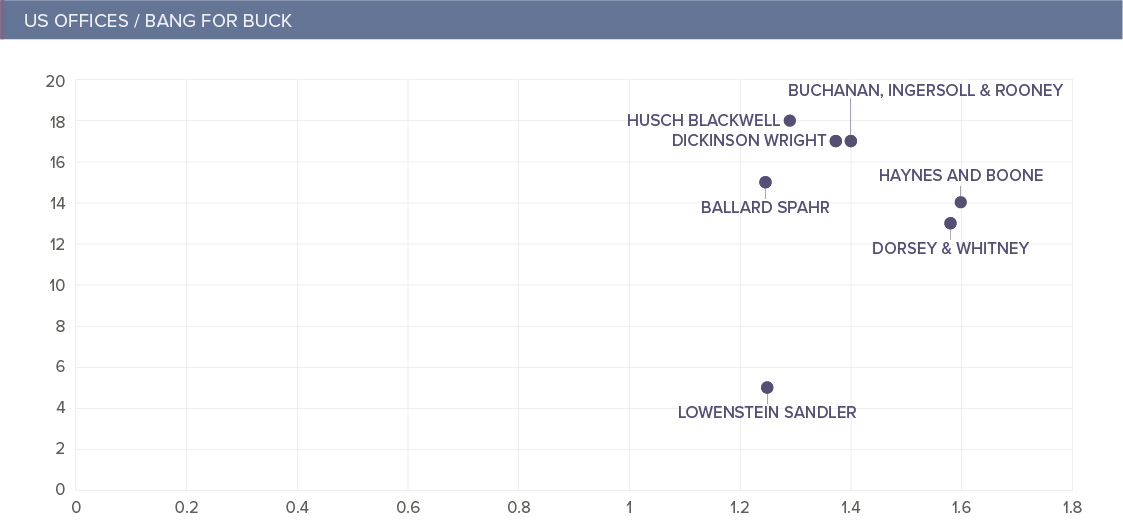

Guns for hire – the power of external support
Many of the Global 200 will employ an outside team of media professionals. But, according to Murray Coffey, Chief Marketing Officer at Haynes and Boone, success depends on finding the right partner.
When Coffey arrived at Haynes and Boone the firm had been spending a large sum of money with a PR consultancy that resulted in “little or no media coverage,” he says, “it then took one more run with another shop before we finally found the sweet spot in terms of media consulting.”
He points out that it was tricky getting the firm to believe that “this time” it will work. According to Coffey, “lawyers have notoriously low resilience,” so taking multiple runs at a topic after an initial misfire “is challenging.”
On getting the best out of an external partner, Coffey advises that you need to treat them as an extended part of your team and invest in the relationship, making sure that they receive due credit within the firm. According to him, too many in-house professionals think they need to keep the outside team “on the down-low” which he identifies as a mistake – “the outside team’s success is your success,” he comments.
With respect to enhancing media footprint, Coffey says, “in almost every instance a top-tier external team, fully supported and engaged with the in-house team, can provide better results,” and, he adds, “at a far more favourable price point.”
Who’s the Most Vocal?
The research also looks at media mentions compared to number of lawyers at each firm to give a most vocal ratio.
Number one by this measure was Wachtell, Lipton, Rosen & Katz (the 58th largest firm in the world) with a ratio of 2.63 media mentions to each lawyer at the firm (5.26 annualised).
Average media mentions per lawyer across the Global 200 comes to 0.51 (1.02 annualised). However, results show that the Global 100 firms on average secured greater media mentions per lawyer than the next 100 – 0.59 (1.17 annualised) to 0.44 (0.88 annualised) respectively. Although it is not possible from this data to understand the precise cause of this, it is possible to speculate that the increased volume of coverage per lawyer is at least in part influenced by the general media tailwind already found to accompany size of firm.
As Groves explains: “You are spoiled in a way – no one’s not going to take your call, no one will say ‘Clifford who?’.” Groves also suggests that it is often easier for lawyers’ voices at the larger firms to cut through because of their numerous high-calibre clients. As she says: “Partners can become real go-to sources because of the sorts of clients that they are dealing with. They are often working on very high-level matters on a continuous basis.”
When it comes to creating a more vocal team, Groves has some sage advice: “There are some lawyers that are fully on board, some that will never get it and those in the middle who are your conversion targets.”
She also highlights how those lawyers who work to develop successful media profiles will often drive a culture of media engagement within a firm: “Where one practice takes a lead, often firms then see the need to level-up their profile elsewhere to more accurately reflect all that they do.”
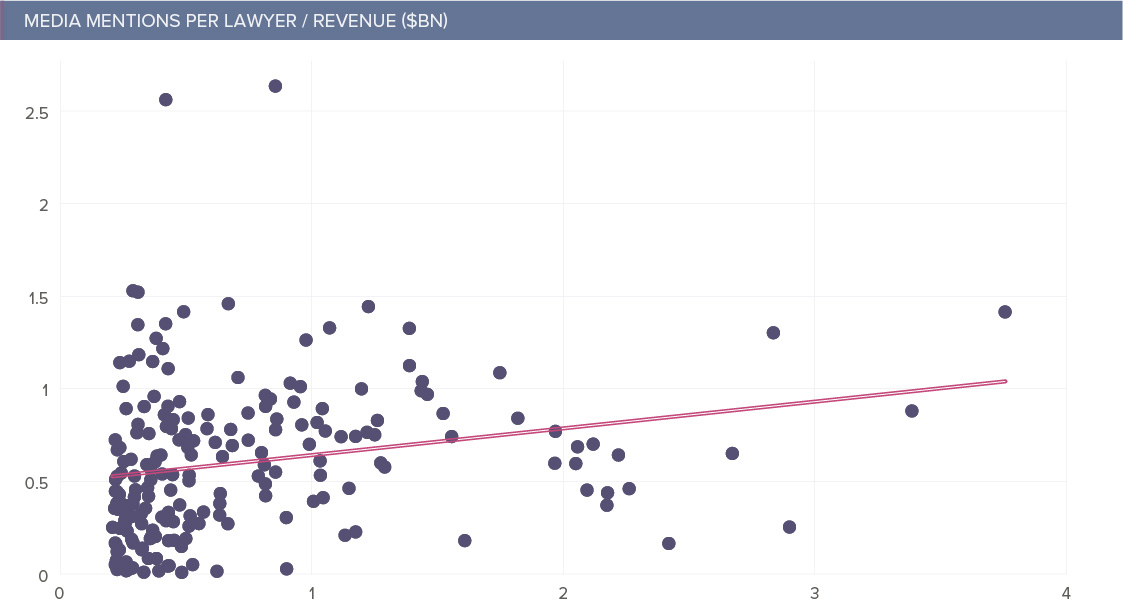
Profile as risk management
“The bigger you get the more opportunities there are for things to go wrong.” Says Anne Groves, former Global Head of PR at Clifford Chance. According to Groves there is a clear rationale behind building a strong media profile which can “greatly assist law firms in promoting themselves and generating new business.” However, more commonly overlooked is the ability of profile, and strong media relationships, to protect reputation in times of trouble.
“Something will go wrong,” says Groves, “with a client, a rogue partner or a disaffected ex-associate feeding bad news into the market. All will cause problems at some point,” and make a firm “the focus of unhelpful comment.” This is where profile becomes an integral part of a firm’s risk management toolkit.
According to Groves, “If you’ve done nothing to nurture media relationships, you’ve forfeited any understanding of your firm.” But, if media relationships are in place – and a firm has invested in its profile consistently – the media are far more likely to understand, and, furthermore, trust it. As Groves says, “if there’s bad publicity coming, this will help to mitigate it,” and where a firm is already comfortable with media engagement, “there is much less chance of panic” if the story does break.
However, this ability for profile to provide greater resilience to risk needs to be underpinned by robust procedures. “The really important thing is to keep the internal lines of communications between your people fluid and continuous,” says Groves and when things do go wrong “make sure they are aware and informed” in order to avoid exacerbating the problem – “the ‘nobody must know anything about this’ mindset is entirely wrong.”
Groves also points to the value of a second pair of eyes in such situations, noting that external media advisors should always be some of the first people to be told about an emergent issue. “Your agency can only be as effective as you allow them to be” says Groves, “it’s no use bringing them in when it’s too late.”
The Covid-19 factor
During our research period the world was hit by the Covid-19 pandemic. This development dominated media reporting and will have caused firms to alter media strategies dramatically.
By looking at the percentage of firms’ media mentions that relate to Covid-19 we can estimate the Covid-19 Alignment of their media profile. This is an indication of the firms that have been swift to react to the changed media landscape and re-position their communications activity.
On this measure, Clayton Utz scores highest with a Covid-19 Alignment of 42.25%.
Mishcon de Reya scores highly again, coming in second with a Covid-19 Alignment score of 41.5%. This suggests a correlation between Covid-19 Alignment and Bang for Buck success. Indeed, the data shows that the top ten firms by revenue have an average Covid-19 Alignment score of only 15%, while the top ten by Bang for Buck average 25% of mentions that also feature the term Covid-19.
This correlation is likely a confirmation of the issues driven nature of the top ten Bang for Buck’s media engagement and speaks to strategies that are either more reactive in nature or easily refocussed to align with the news agenda. Geffin confirms this approach: “As a firm of lawyers, we know that we are not going to lead the news agenda – our strategy is to follow it and react. Our role is to enhance a story by understanding what the media wants from lawyers.”
For Haynes and Boone Covid-19 made it paramount to press on with communications and ensure visibility as a key adviser on areas of pandemic-related concern. Coffey explains: “Covid-19 didn’t cause a material variance in our strategy, other than reaffirming that we needed to say ‘damn the torpedoes’ and keep moving forward . We looked to our media team to help us identify the hot topics and provided media comment to keep our clients aware of the rising issues.”
Geffin also points out that Mishcon de Reya’s Covid-19 Alignment score will have been enhanced by coverage of the firm’s role in a number of highly newsworthy disputes arising from Covid-19 claims. “The work is the most important thing,” she comments, “and the more interesting it is, the better the publicity.”
This trend is also seen in Clayton Utz’s media mentions with its work on the recapitalisation of Virgin Australia, following Covid-19 travel restrictions, receiving significant attention.
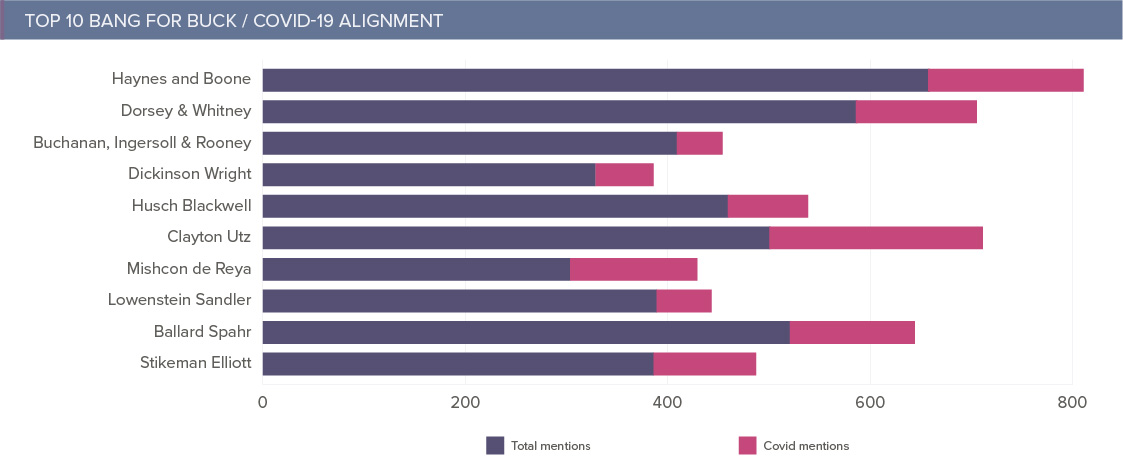
How can we help?
Get in touch with us or find an office close to you
Crisis and litigation
Infinite Global advises a wide range of domestic and international clients facing difficult scenarios in which reputational, legal and commercial risk is high. We advise organizations and individuals, providing counsel and tactical support to mitigate risk and protect reputations when it matters most.
Read More
Professional services
Professional services firms must advance their own brands, while being sensitive to their clients’ objectives and conflicts. We help them show their expertise without compromising relationships.
Read More
Legal
Legal PR demands substantive knowledge of the full range of legal practice areas, the internal dynamics of law firms, and the nuances of relevant media — from the global business press to niche trade publications.
Read More
PR
Effective public relations changes perceptions by creating impressions and inspiring trust. Our team of media experts, including former journalists, provides experienced representation across every segment of the media, from international and broadcast outlets to industry and trade publications, to build brand recognition and enhance reputation.
Read More
